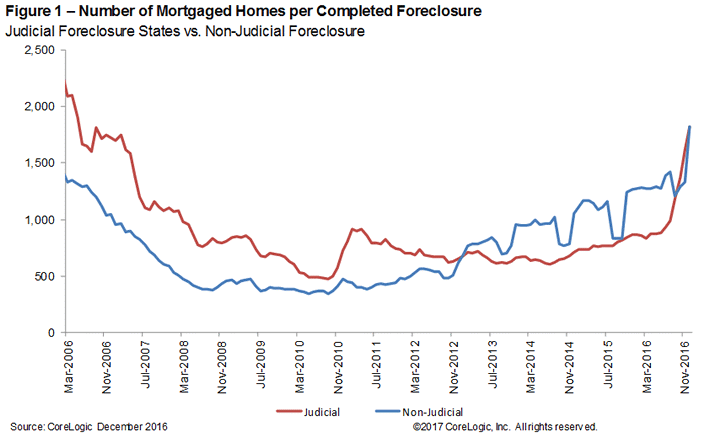Both the size of the foreclosure inventory and the number of foreclosures completed declined by large percentages from December 2015 to December 2016. CoreLogic, in its monthly National Foreclosure Report, puts the number of completed foreclosures nationwide at 21,000 in December, a 40 percent decline from the 36,000 homes that were foreclosed a year earlier.
On a month-over-month basis, completed foreclosures were down by 8.1 percent compared to November when 23,000 homes were foreclosed. As a basis of comparison, before the decline in the housing market, completed foreclosures averaged about 22,000 per month nationwide between 2000 and 2006.

December's foreclosures were down 82 percent from the peak month of September 2010, just before the nationwide foreclosure moratorium was instituted, a month when there were 118,336 foreclosures. A total of 6.5 million bank repossessions have been completed since September 2008.
The five states with the highest number of completed foreclosures in the 12 months ending in December 2016 were Florida (45,000), Michigan (30,000), Texas (24,000), Ohio (21,000) and California (19,000). These five states accounted for 36 percent of all completed foreclosures nationally.
The number of properties currently in process of being foreclosed, the foreclosure inventory, included approximately 329,000 homes at the end of December. This is 0.8 percent of all homes with a mortgage. The inventory shrunk by 30 percent from December 2015 to December 2016, from 467,000 homes, or 1.2 percent of mortgaged homes. On a month-over-month basis, the inventory declined by 1.9 percent.
The largest foreclosure inventory rates in December were in New Jersey (2.8 percent), New York (2.7 percent), Maine (1.8 percent), Hawaii (1.7 percent) and the District of Columbia (1.6 percent).
CoreLogic also reports that the number of mortgages in serious delinquency (defined as 90 days or more past due including loans in foreclosure or REO) declined by 19.4 percent from December 2015 to December 2016 with 1 million mortgages, or 2.6 percent, in serious delinquency, the lowest level since August 2007. The decline was geographically broad with year-over-year decreases in serious delinquency in 48 states and the District of Columbia.
"While the decline in serious delinquency has been geographically broad, some oil-producing markets have shown the effects of low oil prices on the housing market," said Dr. Frank Nothaft, chief economist for CoreLogic. "Serious delinquency rates rose in Louisiana, Wyoming and North Dakota, reflecting the weakness in oil production."
"Foreclosure and delinquency trends continue to head in the right direction powered principally by increasing employment levels, stringent underwriting standards and higher home prices over the past few years. We expect to see further declines in delinquency and foreclosure rates in 2017," said Anand Nallathambi, president and CEO of CoreLogic. "As the foreclosure inventory diminishes, we must look ahead and tackle tight housing supply and growing affordability issues which are keeping many potential homebuyers, especially first-time buyers, on the sidelines."







